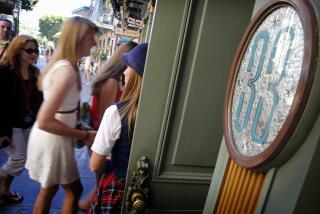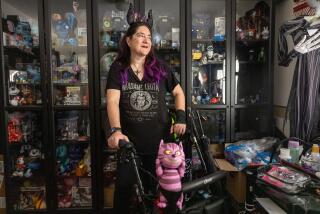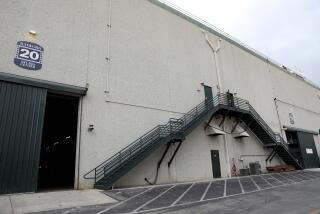Plaintiffs Suing Disney In for a Rough Ride
Eleven-year-old Inderjit Dosanjh flew out of Disneylandâs Tea Cup ride, fractured a vertebra and ended up in a body cast for four months. Though a jury decided the theme park was not at fault, an angry Orange County Superior Court judge called the verdict a âmiscarriage of justice.â He accused Disneyâs attorneys of hiding a key witness and improperly influencing the jury and granted the boy a new trial.
Disneyland prides itself on being the Happiest Place on Earth and one of the safest--and for millions of visitors each year, it is. But some who have gotten hurt at the fabled park and sought redress for their injuries have found themselves battling an aggressive and well-financed corporate giant whose legal tactics, while not uncommon, sometimes contrast sharply with its public image.
In one case, a juror complained first to the judge and then to Disneyland officials that the deliberations were tainted because of pro-Disneyland sentiment among jurors. Plaintiffsâ attorneys say the attitude is common in Orange County.
In other cases, court documents show, Disney has investigated the intimate details of plaintiffsâ personal lives and brought them into the public record, concealed evidence and kept records of injuries at the park secret. Its legal strategies prompted one judge recently to sanction the company and another, in the Tea Cup case, to accuse it in writing of misconduct.
Disney attorneys would not discuss their overall litigation strategy, so it is difficult to know the extent of such practices by the park, which has been sued more than 150 times over the past five years.
But a Times review of a number of recent, hard-fought cases, while not a definitive compilation of Disney litigation, provides a glimpse into a side of the amusement park company that few are aware of.
Disneyland spokesman Ray Gomez said that when a complaint has merit, the Walt Disney Co. often settles the case. But the company will âvery assertivelyâ fight cases it views as frivolous, he said.
âLarge companies like Disney are perceived to have deep pockets and weâre obviously sued on frivolous grounds fairly frequently,â he said. âWhen that occurs, we defend ourselves vigorously.â
People who have sued the park can attest to its aggressive posture.
In addition to the case involving the 11-year-old boy, there are these:
* A 36-year-old woman who said she suffered permanent hearing damage at the park was followed and videotaped by investigators working for Disney, which also questioned the parents of children in the day-care center she ran and subpoenaed her therapistâs records, according to records and interviews.
* A 17-year-old whose finger was ripped from his hand on Splash Mountain later found that Disneyland workers had cleaned up the scene and tightened the screw that had snagged his ring before accident photos were taken, court records and testimony show.
* A 43-year-old woman who sued after she suffered a brain hemorrhage while on the Indiana Jones Adventure was informed in court papers that she assumed the risk of injury when she rode the attraction.
âI was shocked,â said Barry Novack, the womanâs attorney. âI said, âAre you telling the public that getting a brain bleed is an inherent risk of riding Indiana Jones?â
Some legal experts and analysts say Disney must employ tough tactics to protect itself and its reputation in a litigious society. Being tough makes people think twice about suing Disney because it will be so costly, time-consuming, and unpleasant, experts say.
âThe message theyâre sending is to the plaintiffs bar in Orange County,â said legal ethics professor Stephen Gillers of New York University. The message, he said: ââWeâd rather spend seven figures than pay you five.ââ
âItâs standard,â Gillers said, âfor many large companies to make the price of an aggressive lawsuit against them too high as a way of discouraging the plaintiff. They have to be tough, even in cases where theyâre most vulnerable, to get a reputation for not being soft.â
âThey Try to Break You,â Plaintiff Says
The issue of safety at the park and Disneyâs efforts to protect its image came into sharp focus Christmas Eve, when a worker attempted to tie up the sailing ship Columbia to a dock. A cleat--a metal piece with prongs for attaching a rope--broke free from the ship and flew into a group of tourists, killing a Washington man and injuring his wife and a dock worker.
Disney officials came under criticism for cleaning up the scene and boxing up evidence before police or investigators for the state Occupational Safety and Health Administration could arrive. Though the coroner has ruled the incident an accident, Cal/OSHA is probing whether Disneyland was misusing the cleat and whether it had adequately trained the worker. On Wednesday, Disneylandâs new operations chief said the park is launching a ride-by-ride review of how all its attractions are run, and already is changing procedures for the Columbia.
Earlier this month, issues of privacy and safety were raised when a Los Angeles Superior Court officer fined Disneyland $7,050 for blocking efforts by Zipora Jacob, the woman who says she suffered a brain hemorrhage at the park, to obtain documents regarding injury and safety records.
Jacobâs case began in July 1995 after she rode the Indiana Jones ride with her two children. When the ride was over, she staggered out, vomited and collapsed, her suit claims. She later underwent four surgeries to treat a subarachnoid hemorrhage that led doctors to implant a permanent shunt in her brain, she claims.
While such a hemorrhage can result from extreme shaking, Disneyâs Gomez said defense attorneys believe Jacob might have had a predisposition to such a medical problem.
Attorney Novack, who has won judgments against Levolor Inc. blinds and Evel Knievel, said Disney has been one of his most formidable opponents.
But he--and other attorneys who regularly sue Disney--still are surprised that Disney attempted to get the case dismissed by arguing that those who ride the parkâs thrill rides assume a risk of such an injury. Park-goers, Disney contended, assume an inherent risk similar to someone taking a white water rafting trip or going horseback riding.
In his response, Novack argued: âA mother who goes on a Disneyland ride with her children does not suspect, consider or even contemplate that going on the attraction is going to carry some inherent risk of injury.â
The judge ruled in his favor, and the case is expected to reach trial this spring.
The volumes of court records compiled since the case was filed in July 1996 detail an often bitter battle over safety records, with Disney attorneys arguing at times that injury records didnât exist, only to have their availability verified by a Disney employee under oath, depositions filed in the case show.
Disneyâs attorney on the case, Stephen T. Waimey of the law firm Lewis, DâAmato, Brisbois & Bisgaard, did not respond to telephone calls for comment.
Irvine attorney Elizabeth Livesay Fry said she encountered a similarly difficult battle against Disney before settling a case for $180,000 on the eve of trial in 1994.
Her client, Elizabeth Venema, was watching the preview of the new Fantasmic attraction in May 1992 when a cannon aboard the sailing ship Columbia fired near her, causing permanent damage to her auditory nerves. The cannon later was found to produce noises louder than levels that cause hearing damage and louder than Cal/OSHA allowed, according to sworn testimony and interviews. Two UCLA doctors hired by Disneyland confirmed Venemaâs hearing damage, the interviews show.
Disney offered a small sum to settle, Livesay Fry said. When Venema didnât accept, investigators for Disneyâs attorneys videotaped her around her town, on a trip to San Francisco and playing with her toddler daughter, said Venema and her husband, Steve, who demanded to view the tapes as part of their settlement with the park.
Disney attorneys also subpoenaed the records of the therapist Venema went to after her brotherâs death, Livesay Fry said, then argued that the emotional distress she claimed to have suffered because of the hearing damage was just as likely to have resulted from family problems she had as a child.
âThey try to break you,â Elizabeth Venema said. âThey deposed my employees. They deposed every client I have. They even tracked down my past clients. My friends called me up and said they were asking questions like, âDid you ever see her kiss her daughter on the lips?â
âIt was very frightening.â
But even trailing someone with a video camera is not uncommon, professor Gillers said. In Venemaâs case, he said, âthey may have done it to show, despite what the experts say, she was still able to perform the tasks of daily life.â Large corporations âalso recognize that the plaintiff will find such investigations uncomfortable or invasive and might be willing to settle for less,â he said.
Last Big Victory vs. Park Was in â86
Local attorneys also say they fight an uphill battle finding an impartial jury in Orange County, where most of the cases are tried. The park benefits from a âhaloâ effect, attorneys say, the goodwill bred from visitorsâ happy experiences at the Magic Kingdom.
Several lawyers said one attorney defending Disney plays to those memories, wearing a Mickey Mouse tie in front of the jury during cases.
James Eubanks said he and his girlfriend were on the Splash Mountain ride in September 1996 when the log jerked forward. Eubanks said he flung his hands out and caught his ring on a screw protruding from a hatch on the top of the flume ride. The force wrenched his finger off from above the socket.
After the accident a maintenance worker tightened the screw and the blood was cleaned up before photos of the accident site were taken, according to the depositions of employees and court testimony.
A year later, an Orange County jury decided in Disneyâs favor. Some jurors felt that Eubanks should not have had his hands outside the ride. The park warns patrons to keep their hands and feet inside the ride at all times.
Gisela Burmeister, one of the jurors in the case, said some of her co-jurors were clearly pro-Disney before deliberations even started. One juror, she said, was employed by the city of Anaheim and continually praised the park and said how bad it would be to ruin its pristine safety record.
Burmeister said she was so angry during jury deliberations that she wrote a letter to the judge and, after the verdict, to Disneyland officials.
âThe young man only had asked for his medical bills of $21,016 and the loss of his wages $9,600 to be reimbursed. Nothing big!â wrote Burmeister, a Newport Beach real estate agent. âI donât feel that Disney cares about its accidents, and is only concerned with a âcleanâ record.â A Disney official wrote back that park officials âdeeply regretâ the injury, but felt the verdict was fair.
Plaintiffsâ attorneys win so infrequently that they speak in reverent tones of the last big victory against the park in 1986.
Fullerton attorney John Luetto won $600,000 for the mother of a Riverside teenager who was stabbed during a fight at Tomorrowland in 1981. Jurors found that Disneyland was negligent in not summoning paramedics to the park, instead transporting the 18-year-old in a park-owned van to a nearby hospital. Mel C. Yorba bled to death in the hospital parking lot, Luetto said.
âIt was the last, and possibly the only successful injury case against Disney,â said Luetto, who once worked aboard the Columbia.
Despite his victory, Luetto said he tells most clients, âIf you take the case to court, youâre likely to lose.â
Beverly Hills attorney David Glickman thought he had lost when a jury found in favor of Disneyland in February 1997 despite evidence that his client, an 11-year-old Fresno boy, fractured a vertebra and suffered a concussion after he was flung from a spinning Tea Cup near the Alice in Wonderland ride.
âEverybody on the jury had been on the Tea Cups. All 12. You couldnât find one that hadnât,â Glickman said.
But the Orange County Superior Court judge on the case refused to accept the juryâs decision.
âThe verdict reached by the jury results in a miscarriage of justice,â wrote Judge Donald Smallwood in a seven-page motion granting Inderjit Dosanjh a new trial. âPlaintiff established that defendant breached its duty by failing to provide a safe vehicle.â
Smallwood said the Tea Cup that the boy was riding in had not been properly maintained and the post-accident inspection had been inadequate.
Disneyland was âguilty of misconductâ for producing a witness at the last minute that Disney security guards had known about from the start, then lying about it, Smallwood wrote.
âEven giving defense counsel the benefit of the doubt, it is clear that defendant Disneyland Inc. falsely answered plaintiffâs discovery requests for the names and addresses of all witnesses known to them,â Smallwood wrote.
Disney has appealed Smallwoodâs decision.
*
Times staff writers Ray Herndon and E. Scott Reckard contributed to this report.
More to Read
Inside the business of entertainment
The Wide Shot brings you news, analysis and insights on everything from streaming wars to production â and what it all means for the future.
You may occasionally receive promotional content from the Los Angeles Times.










